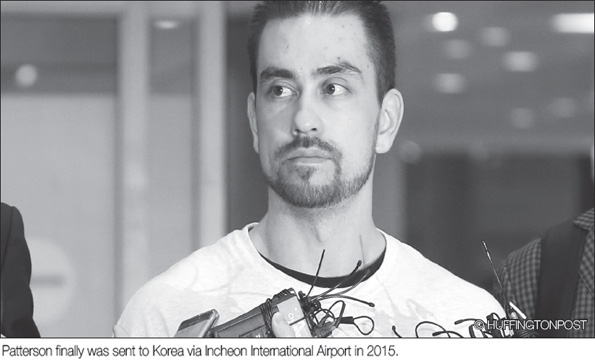
Arthur John Patterson, who has been strongly considered as a murder suspect for an Itaewon murder, was finally convicted 19 years after the murder happened in 1997. When Patterson was 18 years old, he was suspected of murdering a 22-year-old man, Cho Choong-pill, who was attending Hongik University. However, Patterson fled Korea to the United States due to a lack of evidences and a lax system, so the case remained unsolved for a very long time. It happened in a fast food restaurant in Itaewon, so people call it the case of the Itaewon murder.
In 1997, the strongest suspects were Patterson and his friend Edward Lee, who was an 18-year-old Korean American. At that time, Patterson said that he just watched the murder and did not commit the crime directly. His friend Edward Lee also denied the crime and pegged Patterson as the murderer. After the prosecution completed an investigation, Patterson was indicted for possessing a weapon, and Edward was indicted for the murder. However, Edward received a verdict of not guilty for the murder, and Patterson was sentenced to one year and six months imprisonment, but he was given a particular pardon on Korea Independence Day. Thus, the family of the victim requested a reinvestigation of Patterson, but he ran away to the U.S. because prohibition of his departure was not extended. Thus, the case remained unsolved for a very long time although one of them was clearly a murderer.
For 4 years after Patterson fled, the family of the victim collected petitions and handed them to the prosecution to extradite Patterson from the United States. However, the only response from Korea and the United States government was that they couldn’t find the suspect. As time passed by, the prosecution and the government virtually gave up on the extradition of Patterson. After many people forgot the case of the Itaewon murder, a movie called “Where the True Lies”, which was based on the real story of the case, brought attention to the case again. After the movie was released in 2009, many people paid attention to the case of the Itaewon murder, and the prosecution started to reinvestigate the case. After that, the government officially requested an extradition of Patterson by the U.S. government in 2009. However, the extradition was persistently postponed because Patterson filed a series of lawsuits to fight it. After 6 years, in 2015, Patterson finally was sent to Korea via Incheon International Airport.
In January, 2016, Patterson officially appeared at a court for the suspicion of the murder. In this trial, Patterson was convicted of the murder, and he was sentenced to 20 years imprisonment. In general, people who commit a murder are sentenced to life in prison. However, Patterson was a minor when he committed the crime, so he was not sentenced to life in prison. Though, considering that Patterson does not accept his guilty verdict and still shifts the blame to Edward, the court gave Patterson the highest penalty which it can sentence for minors. When the murder happened in 1997, the prosecution guessed that a big person can more easily commit a murder than a small person, so it pegged Edward as the criminal because his height was more than 180cm. However, in this trial, the court decided that size is not related to the possibility of the murder. Moreover, Patterson’s clothes were stained by a lot of blood because the victim was stabbed 9 times, but Edward’s clothes were relatively clean. Also, Patterson’s testimony was inconsistent and not objective, but Edward’s testimony was so consistent. For these reasons, the court convicted Patterson of the murder.
The case was not totally solved because Patterson appealed to the higher court and appointed a Korean lawyer. However, he was already sentenced to imprisonment, so the next trial will proceed on the condition that Patterson is in prison. The next trial will be shorter than the first because all of the evidence was already collected. Thus, the possibility that the court reverse the decision of the first trial is very low. The next trial is likely to focus on confirmation of the sentence and the adequacy of evidence. Moreover, the court pegged Edward as an accomplice of the murder at the first trial, but Edward received a verdict of not guilty in 1998. Thus, the court can’t judge Edward again for the murder by a prohibition against double jeopardy. Thus, his position is under scrutiny by the public.
By Yoo Han-bin
hb36@cbnu.ac.kr


 All
All Society & Global
Society & Global






 Yoo Han-bin
Yoo Han-bin











